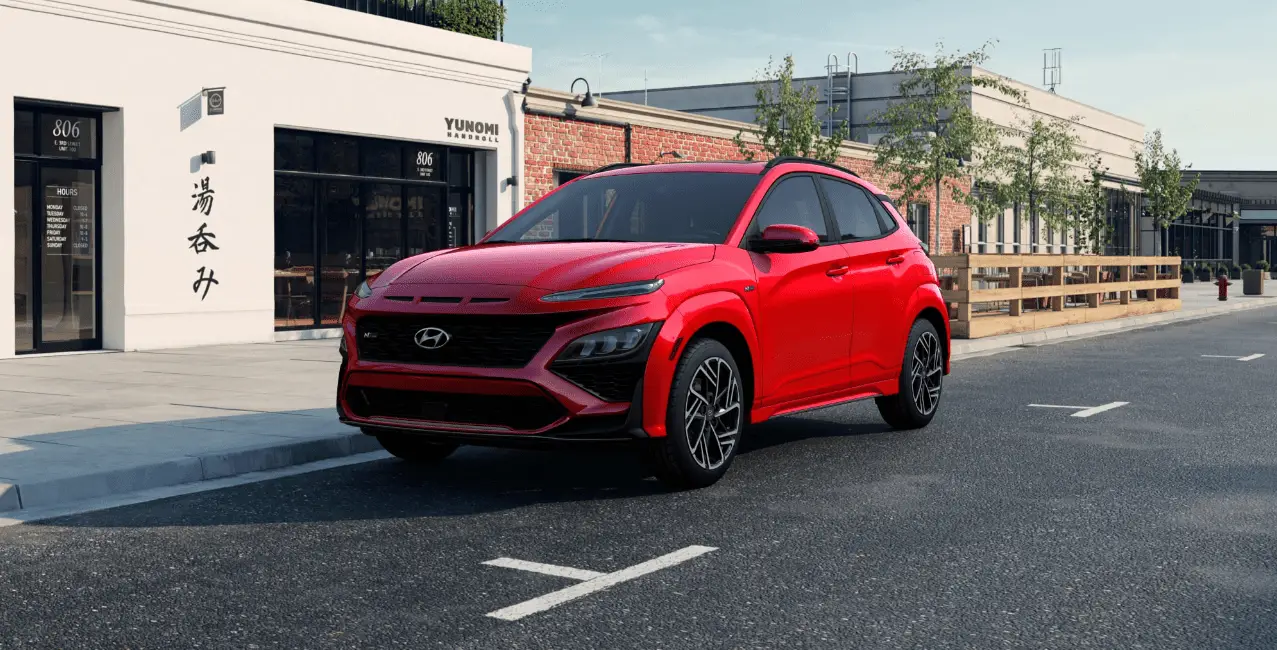Hyundai Kona 2023 Forward Collision-Avoidance Assist (FCA) (Sensor fusion)
The Hyundai Kona 2023 is a subcompact SUV that prioritizes safety, offering advanced safety features to prevent collisions and protect drivers and passengers. One of its most notable safety features is the Forward Collision-Avoidance Assist (FCA) system which uses sensor fusion technology. The system combines radar and camera sensors to detect potential collisions with vehicles and pedestrians in the Kona’s path. Upon detecting a possible collision, the system alerts the driver and applies the brakes automatically to help prevent or reduce the impact. The FCA system is designed to operate at speeds up to 75 mph and is designed to support the driver’s attention and judgment. The Hyundai Kona 2023 also offers other safety features, such as Lane Keeping Assist, Blind-Spot Collision Warning, Rear Cross-Traffic Collision Warning, and Driver Attention Warning. Overall, the Forward Collision-Avoidance Assist system is an essential safety feature that helps prevent accidents and keep the Kona occupants safe.
2023 Hyundai KONA Specs, Price, Features, Milage (Brochure)
Forward Collision-Avoidance Assist (FCA) (Sensor fusion)
Basic function
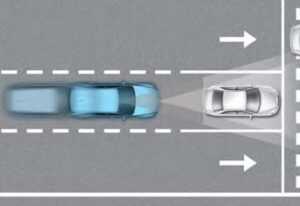
Forward Collision-Avoidance Assist is designed to help detect and monitor the vehicle ahead or help detect a pedestrian or cyclist in the roadway and warn the driver that a collision is imminent with a warning message and an audible warning, and if necessary, apply emergency braking.
Detecting sensor

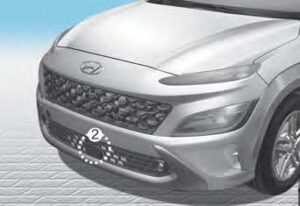
- Front view camera (if equipped)
- Front radar
Refer to the picture above for the detailed location of the detecting sensors.
CAUTION
Take the following precautions to maintain optimal performance of the detecting sensor:
- Never disassemble the detecting sensor or sensor assembly, or apply any impact on it.
- If the detecting sensors have been replaced or repaired, have your vehicle inspected by an authorized HYUNDAI dealer.
- Never install any accessories or stickers on the front windshield, or tint the front windshield.
- Exercise extreme caution to keep the front view camera dry.
- Never place any reflective objects (for example, white paper, a mirror) over the dashboard. Any light reflection may prevent the function from functioning properly.
- Do not place any objects near the front windshield or install any accessories on the front windshield. It can affect the performance of the defogging and defrosting function of the climate control system, which may prevent the Driver Assistance systems from operating.
- Do not apply license plate frame or objects, such as a bumper sticker, film or a bumper guard, near the front radar cover.
- Always keep the front radar and cover clean and free of dirt and debris.
Use only a soft cloth to wash the vehicle. Do not spray pressurized water directly on the sensor or sensor cover. - If unnecessary force has been applied to the radar or the area around the radar, Forward Collision-Avoidance Assist may not properly operate even though a warning message does not appear on the cluster. Have the vehicle be inspected by an authorized HYUNDAI dealer.
- Use only genuine parts to repair or replace a damaged front radar cover. Do not apply paint to the front radar cover.
Forward Collision-Avoidance Assist Settings
Setting features
Forward Safety
With the engine on, select ‘Driver Assistance > Forward Safety’ from the Settings menu to set whether or not to use each function.
- If ‘Active Assist’ is selected, Forward Collision-Avoidance Assist will warn the driver with a warning message and an audible warning depending on the collision risk levels. Braking assist will be applied depending on the collision risk.
- If ‘Warning Only’ is selected, Forward Collision-Avoidance Assist will warn the driver with a warning message and an audible warning depending on the collision risk levels. Braking will not be assisted. The driver must apply the brake pedal or steer the vehicle if necessary.
- If ‘Off is selected, Forward Collision-Avoidance Assist will turn off. The warning light will illuminate on the cluster.
The driver can monitor Forward Collision-Avoidance Assist ON/OFF status from the Settings menu. If the warning light remains ON when the vehicle is ON, have the vehicle inspected by an authorized HYUNDAI dealer.
WARNING
When the engine is restarted, Forward Collision-Avoidance Assist will always turn on. However, if ‘Off’ is selected, the driver should always be aware of the surroundings and drive safely.
CAUTION
If ‘Warning Only’ is selected, braking is not assisted. The settings for Forward Safety include ‘Basic function’.
Information
Forward Collision-Avoidance Assist will turn off when ESC is turned off by pressing and holding the ESC OFF button. The warning light will illuminate on the cluster.
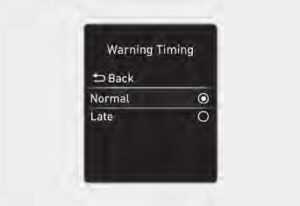
Warning Timing
With the engine on, select ‘Driver Assistance > Warning Timing’ from the Settings menu to change the initial warning activation time for Forward Collision-Avoidance Assist. When the vehicle is first delivered, Warning Timing is set to ‘Normal. If you change the Warning Timing, the warning time of other Driver Assistance systems may change.
Warning Volume
With the engine on, select ‘Driver Assistance> Warning Volume’ from the Settings menu to change the Warning Volume to ‘High’, ‘Medium’ or ‘Low’ for Forward Collision-Avoidance Assist. If you change the warning volume, the Warning Volume of other Driver Assistance systems may change.
CAUTION
The setting of the Warning Timing and Warning Volume applies to all functions of Forward Collision-Avoidance Assist. Even though ‘Normal’ is selected for Warning Timing, if the front vehicle suddenly stops, the initial warning activation time may seem late. Select ‘Late’ for Warning Timing when traffic is light and when driving speed is slow.
Information
If the engine is restarted, Warning Timing and Warning Volume will maintain the last setting.
Forward Collision-Avoidance Assist Operation Basic function
Warning and Control
The basic function of Forward Collision-Avoidance Assist is to help warn and control the vehicle depending on the Collision risk level: ‘Collision Warning, Emergency Braking’ and ‘Stopping vehicle and ending brake control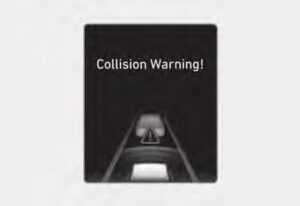
Collision Warning
- To warn the driver of a collision, the Collision Warning warning message will appear on the cluster and an audible warning will sound.
- If a vehicle is detected in front, the function will operate when your vehicle speed is between approximately 6~112 mph (10~180 km/h).
- If a pedestrian or cyclist is detected in front, the function will operate when your vehicle speed is between approximately 6~53 mph (10~85 km/h).
- If Active Assist’ is selected, braking may be assisted. may be assisted.
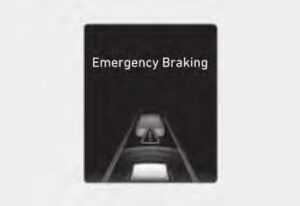
Emergency Braking
- To warn the driver that emergency braking will be assisted, the ‘Emergency Braking’ warning message will appear on the cluster and an audible warning will sound.
- If a vehicle is detected in front, the function will operate when your vehicle speed is between approximately 6-47 mph (10-75 km/h).
- If a pedestrian or cyclist is detected in front, the function will operate when your vehicle speed is between approximately 6-40 mph (10-65 km/h).
- In emergency braking situations, braking is assisted with strong braking power by the function to help prevent collision with the vehicle, pedestrian or cyclist ahead.
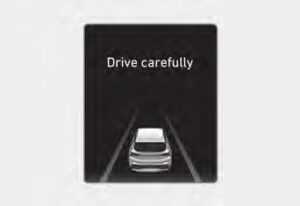
Stopping the vehicle and ending the brake control
When the vehicle is stopped due to emergency braking, the ‘Drive carefully’ warning message will appear on the cluster. For your safety, the driver should depress the brake pedal immediately and check the surroundings. Brake control will end after the vehicle is stopped by emergency braking for approximately 2 seconds.
WARNING
Take the following precautions when using Forward Collision-Avoidance Assist:
- For your safety, only change the Settings after parking the vehicle at a safe location.
- With ‘Active Assist’ or ‘Warning Only’ selected, when ESC is turned off by pressing and holding the ESC OFF button, Forward Collision-Avoidance Assist will turn off automatically.
In this case, Forward Collision-Avoidance Assist cannot be set from the Settings menu and the warning light will illuminate on the cluster which is normal. If ESC is turned on by pressing the ESC OFF button, Forward Collision-Avoidance Assist will maintain the last setting. - Forward Collision-Avoidance Assist does not operate in all situations or cannot avoid all collisions.
- The driver has the responsibility to control the vehicle. Do not solely depend on Forward Collision-Avoidance Assist. Rather, maintain a safe braking distance, and if necessary, depress the brake pedal to reduce driving speed or to stop the vehicle.
- Never deliberately operate Forward Collision-Avoidance Assist on people, animals, objects, etc. It may cause serious injury or death.
- Forward Collision-Avoidance Assist may not operate if the driver depresses the brake pedal to avoid collision.
- Depending on the road and driving conditions, Forward Collision-Avoidance Assist may warn the driver late or may not warn the driver.
- During Forward Collision-Avoidance Assist operation, the vehicle may stop suddenly injuring passengers and shifting loose objects. Always have the seat belt on and keep loose objects secured.
- If any other function’s warning message is displayed or an audible warning is generated, the Forward Collision-Avoidance Assist warning message may not be displayed and an audible warning may not be generated.
- You may not hear the warning sound of Forward Collision-Avoidance Assist if the surrounding is noisy.
- Forward Collision-Avoidance Assist may turn off or may not operate properly or may operate unnecessarily depending on the road conditions and the surroundings.
WARNING
Even if there is a problem with Forward Collision-Avoidance Assist, the vehicle’s basic braking performance will operate normally. During emergency braking, braking control by Forward Collision-Avoidance Assist will automatically cancel when the driver excessively depresses the accelerator pedal or sharply steers the vehicle.
CAUTION
Forward Collision-Avoidance Assist operating speed range may be reduced due to the conditions of the vehicle or pedestrian in front or surroundings. Depending on the speed, Forward Collision-Avoidance Assist may only warn the driver, or it may not operate. Forward Collision-Avoidance Assist will operate under certain conditions by judging the risk level based on the condition of the oncoming vehicle, driving direction, speed and surroundings.
Information
In a situation where collision is imminent, braking may be assisted by Forward Collision-Avoidance Assist when braking is insufficient by the driver. The images and colors in the instrument cluster may differ depending on the cluster type or theme selected from the instrument cluster.
Forward Collision-Avoidance Assist Malfunction and Limitations
Forward Collision-Avoidance Assist malfunction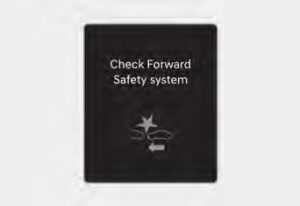
When Forward Collision-Avoidance Assist is not working properly, the ‘Check Forward Safety system(s) warning message will appear, and the And warning lights Will illuminate on the cluster. Have the vehicle inspected by an authorized HYUNDAI dealer.
Forward Collision-Avoidance Assist disabled
When the front windshield where the front view camera is located, the front radar cover or sensor is covered with foreign material, such as snow or rain, it can reduce the detecting performance and temporarily limit or disable Forward Collision-Avoidance Assist. If this occurs the ‘Forward Safety system(s) disabled. Camera obscured’ or the ‘Forward Safety system(s) disabled. Radar blocked’ warning message, and the A and warning lights will illuminate on the cluster. The Forward Collision-Avoidance Assist will operate normally when such snow, rain or foreign material is removed. If the Forward Collision-Avoidance Assist does not operate normally after obstruction (snow, rain, or foreign material) is removed, have the vehicle inspected by an authorized HYUNDAI dealer.
WARNING
- Even though the warning message or warning light does not appear on the cluster, Forward Collision-Avoidance Assist may not properly operate.
- Forward Collision-Avoidance Assist may not properly operate in an area (for example, open terrain), where any substance are not detected after turning ON the engine.
Limitations of Forward Collision-Avoidance Assist
Forward Collision-Avoidance Assist may not operate normally, or it may operate unexpectedly under the following circumstances:
- The detecting sensor or the surroundings are contaminated or damaged
- The temperature around the front view camera is high or low
- The camera lens is contaminated due to tinted, filmed, or coated windshield, damaged glass, or sticky foreign material (sticker, bug, etc.) on the glass
- Moisture is not removed or frozen on the windshield
- Washer fluid is continuously sprayed, or the wiper is on
- Driving in heavy rain or snow, or thick fog
- The field of view of the front view camera is obstructed by sun glare
- Street light or light from an oncoming vehicle is reflected on the wet road surface, such as a puddle on the road
- An object is placed on the dashboard
- Your vehicle is being towed
- The surrounding is very bright
- The surrounding is very dark, such as in a tunnel, etc.
- The brightness changes suddenly, for example when entering or exiting a tunnel
- The brightness outside is low, and the headlights are not on or are not bright
- Driving through steam, smoke, or shadow
- Only part of the vehicle, pedestrian, or cyclist is detected
- The vehicle in front is a bus, heavy truck, truck with unusually shaped cargo, trailer, etc.
- The vehicle in front has no tail lights, tail lights are located unusually, etc.
- The brightness outside is low, and the tail lamps are not on or are not bright
- The rear of the front vehicle is small or the vehicle does not look normal, such as when the vehicle is tilted, overturned, or the side of the vehicle is visible, etc.
- The front vehicle’s ground clearance is low or high
- A vehicle, pedestrian, or cyclist suddenly cuts in front
- Is the bumper around the front radar is impacted, or damaged or the front radar is out of position
- The temperature around the front radar is high or low
- Driving through a tunnel or iron bridge
- Driving in large areas where there are few vehicles or structures (for example, desert, meadow, suburb, etc.)
- Driving near areas containing metal substances, such as a construction zone, railroad, etc.
- A material is near that reflects very well on the front radar, such as a guardrail, nearby vehicle, etc.
- The cyclist in front is on a bicycle made of material that does not reflect on the front radar
- The vehicle in front is detected late
- The vehicle in front is suddenly blocked by an obstacle
- The vehicle in front suddenly changes lanes or suddenly reduces the speed
- The vehicle in front is bent out of shape
- The front vehicle’s speed is fast or slow
- The vehicle in front steers in the opposite direction of your vehicle to avoid a collision
- With a vehicle in front, your vehicle changes lanes at low speed
- The vehicle in front is covered with snow
- You are departing or returning to the lane
- Unstable driving
- You are on a roundabout and the vehicle in front is not detected
- You are continuously driving in a circle
- The vehicle in front has an unusual shape
- The vehicle in front is driving uphill or downhill
- The pedestrian or cyclist is not fully detected, for example, if the pedestrian is leaning over or is not fully walking upright
- The pedestrian or cyclist is wearing clothing or equipment that makes it difficult to detect as a pedestrian or cyclist
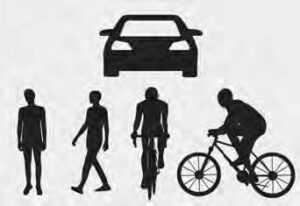
The illustration above shows the image the front view camera is capable of detecting as a vehicle, pedestrian, and cyclist.
- The pedestrian or cyclist in front is moving very quickly
- The pedestrian or cyclist in front is short or is posing a low posture
- The pedestrian or cyclist in front has impaired mobility
- The pedestrian or cyclist in front is moving intersected with the driving direction
- There is a group of pedestrians, cyclists, or a large crowd in front
- The pedestrian or cyclist is wearing clothing that easily blends into the background, making it difficult to detect
- The pedestrian or cyclist is difficult to distinguish from the similarly shaped structure in the surroundings
- You are driving by a pedestrian, cyclist, traffic sign, structure, etc. near the intersection
- Driving in a parking lot
- Driving through a tollgate, construction area, unpaved road, partially paved road, uneven road, speed bumps, etc.
- Driving on an inclined road, curved road, etc.
- Driving through a roadside with trees or streetlights
- The adverse road conditions cause excessive vehicle vibrations while driving
- Your vehicle height is low or high due to heavy loads, abnormal tire pressure, etc.
- Driving through a narrow road where trees or grass are overgrown
- There is interference by electromagnetic waves, such as driving in an area with strong radio waves or electrical noise
-
Driving on a curve

Forward Collision-Avoidance Assist may not detect other vehicles, pedestrians or cyclists in front of you on curved roads adversely affecting the performance of the sensors. This may result in no warning or braking assist when necessary.
When driving on a curve, you must maintain a safe braking distance, and if necessary, steer the vehicle and depress the brake pedal to reduce your driving speed in order to maintain a safe distance.
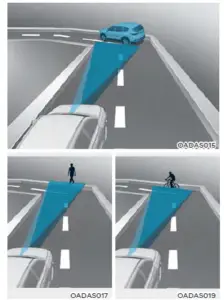
Forward Collision-Avoidance Assist may detect a vehicle, pedestrian or cyclist in the next lane or outside the lane when driving on a curved road. If this occurs, Forward Collision-Avoidance Assist may unnecessarily warn the driver and control the brake. Always check the traffic conditions around the vehicle.
- Driving on a slope

Forward Collision-Avoidance Assist may not detect other vehicles, pedestrians or cyclists in front of you while driving uphill or downhill adversely affecting the performance of the sensors. This may result in unnecessary warning or braking assist, or no warning or braking assist when necessary. Also, vehicle speed may rapidly decrease when a vehicle, pedestrian or cyclist ahead is suddenly detected. Always have your eyes on the road while driving uphill or downhill and if necessary, steer your vehicle and depress the brake pedal to reduce your driving speed in order to maintain a safe distance.
Changing lanes
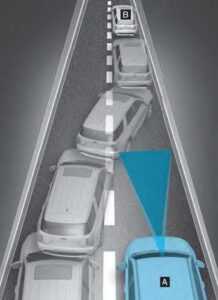
- Your vehicle,
- Lane changing vehicle
When a vehicle moves into your lane from an adjacent lane, it cannot be detected by the sensor until it is in the sensor’s detection range. Forward Collision-Avoidance Assist may not immediately detect the vehicle when the vehicle changes lanes abruptly. In this case, you must maintain a safe braking distance, and if necessary, steer your vehicle and depress the brake pedal to reduce your driving speed in order to maintain a safe distance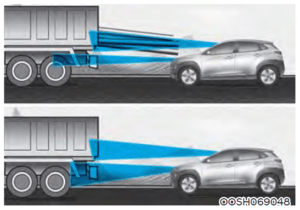
- Your vehicle,
- Lane changing vehicle,
- Same lane vehicle
When a vehicle in front of you merges out of the lane, Forward Collision-Avoidance Assist may not immediately detect the vehicle that is now in front of you. In this case, you must maintain a safe braking distance, and if necessary, steer your vehicle and depress the brake pedal to reduce your driving speed in order to maintain a safe distance.
- Detecting vehicle
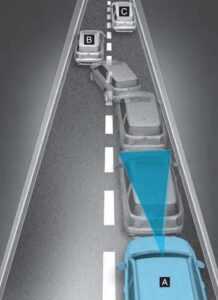
If the vehicle in front of you has cargo that extends rearward from the cab, or when the vehicle in front of you has higher ground clearance, additional special attention is required. Forward Collision-Avoidance Assist may not be able to detect the cargo extending from the vehicle. In these instances, you must maintain a safe braking distance from the rear object, and if necessary, steer your vehicle and depress the brake pedal to reduce your driving speed in order to maintain distance.
WARNING
- When you are towing a trailer or another vehicle, have Forward Collision-Avoidance Assist is turned off due to safety reasons.
- Forward Collision-Avoidance Assist may operate if objects that are similar in shape or characteristics to vehicles, pedestrians and cyclists are detected.
- Forward Collision-Avoidance Assist does not operate on bicycles, motorcycles, or smaller wheeled objects, such as luggage bags, shopping carts, or strollers.
- Forward Collision-Avoidance Assist may not operate normally if interfered by strong electromagnetic waves.
- Forward Collision-Avoidance Assist may not operate for 15 seconds after the vehicle is started, or the front view camera is initialized.
Information
This device complies with Part 15 of the FCC rules.
Operation is subject to the following three conditions:
- This device may not cause harmful interference, and
- This device must accept any interference received, including interference that may cause undesired operation.
- Changes or modifications not expressly approved by the party responsible for compliance could void the user’s authority to operate the device.
Information
Radiofrequency radiation exposure information:
- This equipment complies with FCC radiation exposure limits set forth for an uncontrolled environment.
- This equipment should be installed and operated with a minimum distance of 8 in. (20 cm) between the radiator (antenna) and your body.
- This transmitter must not be co-located or operating in conjunction with any other antenna or transmitter.
FAQ
What is Forward Collision-Avoidance Assist (FCA) in Hyundai Kona 2023?
Forward Collision-Avoidance Assist (FCA) is an advanced safety feature in the Hyundai Kona 2023 that uses sensor fusion technology to detect potential collisions and automatically apply the brakes if necessary.
How does the FCA system work in the Hyundai Kona 2023?
The FCA system in the Hyundai Kona 2023 uses both radar and camera sensors to detect vehicles and pedestrians in the Kona’s path. If a potential collision is detected, the system can provide an alert to the driver and automatically apply the brakes to help avoid or mitigate the impact.
What is sensor fusion technology in the Hyundai Kona 2023?
Sensor fusion technology is a system that combines data from multiple sensors, such as radar and camera sensors, to provide more accurate and comprehensive information about the environment around the vehicle.
What is the maximum speed at which the FCA system operates in Hyundai Kona 2023?
The FCA system in the Hyundai Kona 2023 is designed to operate at speeds up to 75 mph.
Is the FCA system a substitute for the driver’s attention and judgment in Hyundai Kona 2023?
No, the FCA system in the Hyundai Kona 2023 is intended to supplement the driver’s attention and judgment.
What are some other advanced safety features in Hyundai Kona 2023?
Other advanced safety features in the Hyundai Kona 2023 include Lane Keeping Assist, Blind-Spot Collision Warning, Rear Cross-Traffic Collision Warning, and Driver Attention Warning.
What is Lane Keeping Assist in Hyundai Kona 2023?
Lane Keeping Assist is a safety feature in the Hyundai Kona 2023 that helps prevent the vehicle from drifting out of its lane by providing steering assistance.
What is Blind-Spot Collision Warning in Hyundai Kona 2023?
Blind-Spot Collision Warning is a safety feature in the Hyundai Kona 2023 that alerts the driver when another vehicle is in the vehicle’s blind spot.
What is the Rear Cross-Traffic Collision Warning in Hyundai Kona 2023?
Rear Cross-Traffic Collision Warning is a safety feature in the Hyundai Kona 2023 that alerts the driver when another vehicle is approaching from the side while the vehicle is in reverse.
What is the Driver Attention Warning in Hyundai Kona 2023?
Driver Attention Warning is a safety feature in the Hyundai Kona 2023 that monitors the driver’s behavior and alerts the driver if it detects signs of drowsiness or distraction.
Can the FCA system be turned off in the Hyundai Kona 2023?
Yes, the FCA system in the Hyundai Kona 2023 can be turned off if desired.
Is the FCA system standard or optional in the Hyundai Kona 2023?
The FCA system is a standard safety feature in the Hyundai Kona 2023.
Does the FCA system work in all driving conditions in the Hyundai Kona 2023?
The FCA system in the Hyundai Kona 2023 is designed to work in a variety of driving conditions, including city and highway driving.
How does the FCA system affect insurance rates for Hyundai Kona 2023?
The FCA system in the Hyundai Kona 2023 is an advanced safety feature that can potentially lower insurance rates due to its ability to prevent collisions.
Can the FCA system prevent all collisions in the Hyundai Kona 2023?
While the FCA system in the Hyundai Kona 2023 is designed to prevent collisions, it cannot guarantee that all collisions will be avoided.
Useful Links
View Full User Guide: Hyundai Kona 2023 User Guide
Download Manuals: https://owners.hyundaiusa.com/us/en/resources/manuals-warranties.html
2023 Hyundai KONA Specs, Price, Features, Milage (Brochure)

